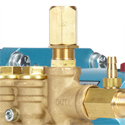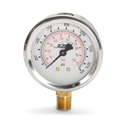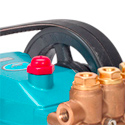Home > Service & Repair Centre > Troubleshooting > Low Pressure
Low Pressure
|
|
|
Worn Nozzle |
|
 Cause Cause
A worn nozzle results in lower pressure because there is less resistance to the water flow. A pump generates flow, not pressure. The orifice size of the nozzle determines the resistance to flow and therefore the pressure created. As the nozzle wears the orifice size increases, which produces less resistance. Often, pressure-related problems are not due to the pump, but due to downstream components.
Solution
Replace nozzle with properly sized nozzle.
View the nozzle selection chart
Back to Top
|
|
Faulty Regulator |
|
|
 Cause Cause
A regulator is a pressure control valve that sets and maintains system pressure. An internal piston shifts based on downstream pressure to allow flow to either travel to the system or back to the source through the by-pass port. A worn or “stuck” piston can cause excess bypass flow and low system pressure.
Solution
Take regulator apart and inspect the piston valve assembly. Look for evidence of wear of lack of movement. Repair and clean as indicated or replace internal piston.
Back to Top
|
|
Worn Seals |
|
|
.jpg) Cause Cause
Over the course of operation, seal wear occurs due to the reciprocating movement of the plunger. Worn seals allow fluid to migrate to the low-pressure side, which can result in a lower flow and thus lower system pressure.
Solution
Inspect and replace seals. Follow service and preventive maintenance recommendations.
Learn More about repairing your pump
Back to Top
|
|
Pressure Gauge |
|
|
 Cause Cause
The pressure gauge displays the system pressure. Gauges can fail due to over-pressurization of pressure spikes. A faulty gauge reading can lead to misinterpreting system conditions and therefore taking inappropriate actions. Always verify system pressure before attempting system maintenance or repairs.
Solution
Replace pressure gauge. In some systems, a pressure diagnostics sensing port can be used to verify system pressure. Use high-quality glycerin-filled gauges with built-in pressure snubbers.
Back to Top
|
|
Belt Slippage (Belt drive units) |
|
|
 Cause Cause
Belt-drives are used to set and control the pump speed, measured in “revolutions-per-minute” or “rpm.” Belt slippage causes the pump to run at a lower speed, which affects pump output flow. Lower flow means resistance to the flow decreases, which translates into lower system pressure. Pressure is the resistance to flow.
Solution
Inspect the belt-drive assembly and belts. Tighten or replace belts as indicated.
Back to Top
|
|
Undersized or Clogged Inlet Filter |
|
|
Cause
An inlet filter removes contamination, preventing it from entering the pump. An improperly sized filter or one that is clogged reduces the amount of liquid to the pump inlet, which can cause cavitation and even severe pump damage. Reduced inlet flow also contributes to reduced flow to the system, which works to reduce system pressure as there is less resistance to the lower flow being produced.
Solution
Inspect filter and filter screen or mesh. Clean per instructions. If filter is damaged, replace. Also, verify filter sizing. A good rule-of-thumb is to match the inlet port size of the pump; do not reduce the filter port size.
Back to Top
|
|
Inadequate Water Supply |
|
|
Cause
Adequate water supply is essential for the operation of the pump. Incoming water lubricates and cools the pump. Water is also required to fill the pump chambers. An inadequate water supply will result in a lower flow being discharged from the pump and therefore lower system pressure. Severely restricting water supply can cause catastrophic pump failure, resulting in system shutdown and the need for a complete pump re-build or total replacement.
Solution
Inspect the incoming line for obstructions or any flow restrictions. Follow pump guidelines for inlet port and line sizing. Increase line size if necessary. Verify supply line pressure and increase if indicated.
Back to Top
|
|
